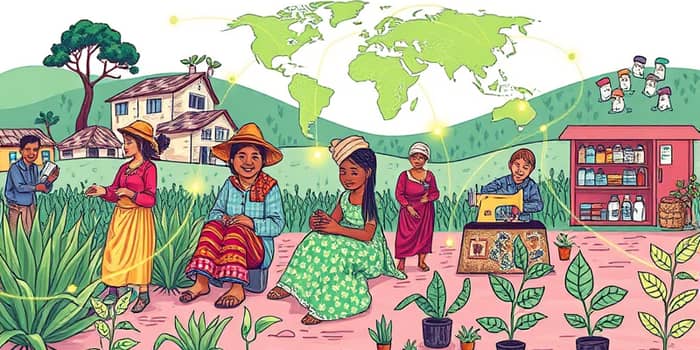Microfinance has emerged as a powerful force in global development, offering financial services to millions excluded from traditional banking. Through small loans, savings accounts, and insurance products, microfinance institutions (MFIs) provide the building blocks for economic stability. Social lending platforms amplify this effect, connecting individual lenders with borrowers worldwide. By merging financial inclusion with community-driven funding, these models unlock opportunities and foster resilience across communities. In this article, we explore the history, mechanisms, successes, and challenges of microfinance and social lending.
Understanding Microfinance: Roots and Evolution
The concept of microfinance took shape in the 1970s, pioneered by institutions like the Grameen Bank in Bangladesh. Its founder, Muhammad Yunus, demonstrated how access to tiny loans could spark entrepreneurial activities among the poorest segments of society. Over decades, the sector expanded from just microcredit to include a broad suite of financial products.
Today, microfinance represents an entire ecosystem designed to deliver critical financial services to underserved or marginalized clients. Historically, these services filled gaps left by traditional banks, which often deemed low-income individuals too risky or unprofitable. By tailoring loan sizes to client needs—ranging from $10 to a few thousand dollars—and leveraging local networks, MFIs cultivated trust and accountability in both rural and urban settings.
Core Products Empowering the Underserved
Microfinance institutions offer diverse products that address different financial needs. The primary offerings include:
- Microcredit and microloans for business startups, education, or emergency expenses.
- Savings and checking accounts that encourage clients to build reserves and manage cash flow.
- Microinsurance to protect against health crises, natural disasters, and crop failures.
- Microleasing and fund transfers for affordable equipment leasing and remittances.
- Financial education workshops covering money management, entrepreneurship, and literacy.
Together, these products form a comprehensive toolkit for economic development, reducing vulnerability and enabling clients to navigate financial challenges with greater confidence.
Delivery Models: Personal and Collective Pathways
Microfinance employs two primary lending models: individual (relationship-based) lending and group lending. In the individual model, clients receive loans based on personal assessments of creditworthiness and business plans. This approach suits borrowers with established enterprises, offering tailored support and flexible repayment schedules.
Group lending, by contrast, binds small clusters of borrowers into a single liability group. Each member’s repayment behaviour influences the group’s future access to credit. This structure harnesses peer pressure helps ensure repayment while creating support networks among participants. For many first-time entrepreneurs, group lending provides both financial resources and community solidarity.
Social Lending: Crowdfunding for Impact
Social lending, often referred to as peer-to-peer (P2P) lending or crowdfunding, has transformed microfinance by introducing digital platforms. Organizations like Kiva enable individuals to fund loans starting as low as $25. Lenders choose specific borrowers, often motivated by personal stories and clear impact goals.
Through online platforms, contributors from around the globe can back projects in rural agriculture, women-led enterprises, or educational initiatives. This democratization of lending brings explicit emphasis on social impact alongside modest financial returns. Borrowers, in turn, gain global visibility and alternative financing sources beyond traditional MFIs.
Achievements and Impact Stories
Since its inception, microfinance has reached millions of clients, enabling small business growth and income stability. As of 2008, MFIs served around 67.6 million clients in over 100 countries. By 2023, the market value of this sector soared to $224.6 billion, with projections reaching $506 billion by 2030.
These figures underscore the transformative power of microfinance initiatives and their ability to uplift communities worldwide.
Challenges and Critiques in Microfinance
Despite its promise, microfinance faces significant challenges. Achieving a balance between financial sustainability and social outreach often proves difficult. Commercial pressures may push MFIs to favor higher-income clients, risking exclusion of the neediest populations.
Critics also warn of over-indebtedness among vulnerable borrowers who take multiple loans to service existing debt. In extreme cases, inadequate consumer protection has led to exploitative interest rates and coercive collection practices. Effective regulation and robust data privacy frameworks remain ongoing concerns, especially as digital platforms collect increasing volumes of client information.
Digital Transformation: The Future of Financial Inclusion
Technological innovations are reshaping microfinance and social lending models. Mobile banking apps, biometric identification, and blockchain-based solutions lower operational costs and expand outreach. Fintech startups partner with MFIs to deliver integrated platforms offering credit scoring, digital wallets, and real-time analytics.
These advances enable seamless digital onboarding of new clients, particularly among youth and urban populations. They also facilitate remote monitoring of loan performance, risk assessment, and tailored financial education. As digital literacy grows, more borrowers can harness online tools to manage savings, invest in businesses, and weather economic shocks.
The Road Ahead: Sustainability and Scaling Impact
As microfinance evolves, stakeholders must prioritize sustainable models that maintain social mission without compromising financial viability. Impact investors, governments, and non-profits can collaborate to create blended finance structures, combining grants with commercial capital. Such partnerships can subsidize services for the poorest while ensuring MFIs remain operationally robust.
Expanding multi-service offerings—such as linking microinsurance with credit products or bundling financial education workshops—can deepen client impact. Integrating environmental considerations, such as green loans for renewable energy projects, aligns microfinance with global sustainability goals. Ultimately, the future of microfinance and social lending lies in fostering inclusive growth through collaborative innovation.
Conclusion: Empowering Communities Worldwide
Microfinance and social lending have proven that financial inclusion is not merely a policy objective but a catalyst for individual dignity and community resilience. By granting access to capital, fostering entrepreneurship, and cultivating trust, these models unlock the potential of millions. Yet, the journey is far from over.
Addressing challenges of scale, regulation, and digital equity will determine how microfinance adapts to future global needs. As technology bridges distances and social lending platforms bring lenders and borrowers closer together across continents, the promise of a more equitable financial landscape remains within reach.
For individuals, communities, and nations striving to break free from poverty cycles, microfinance and social lending offer a roadmap to brighter, self-sustaining futures. With continued innovation, collaboration, and commitment to social impact, this sector can transform lives and reshape economies for generations to come.
References
- https://en.wikipedia.org/wiki/Microfinance
- https://finca.org/our-work/microfinance
- https://www.kiva.org/microfinance
- https://academic.oup.com/oxrep/article/40/1/1/7630840
- https://corporatefinanceinstitute.com/resources/commercial-lending/microfinance/
- https://www.investopedia.com/terms/m/microfinance.asp
- https://www.ebsco.com/research-starters/business-and-management/microfinance










